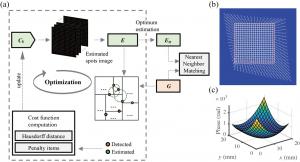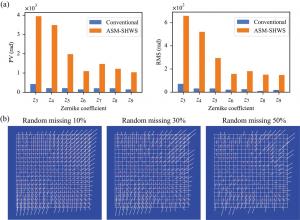New sensor tackles high-curvature wavefront measurement challenges
USA, August 27, 2024 /EINPresswire.com/ -- Conventional Shack-Hartmann wavefront sensors struggle with high-curvature surfaces due to limited dynamic range. This research introduces an adaptive spot matching (ASM) technique that significantly expands the sensor's capabilities. By intelligently matching detected light spots across the entire image, ASM-SHWS can measure even severely curved surfaces, outperforming conventional methods even when some spots are missing. This breakthrough paves the way for more accurate and versatile wavefront measurements in various applications.
Accurately measuring the shape of light waves, or wavefronts is crucial in fields ranging from astronomy to medicine. However, conventional sensors often struggle with severely curved surfaces or missing data points. Now, researchers have developed a revolutionary new sensor that overcomes these limitations, paving the way for more precise and versatile wavefront measurements.
Imagine a tool that precisely measures the shape of light waves, even when they bend and twist dramatically. That's the power of the Shack-Hartmann wavefront sensor (SHWS), a technology used in everything from astronomy to eye exams. But there's a catch: traditional SHWS struggles with highly curved surfaces, limiting its applications.
The innovative ASM-SHWS changes the game. By employing a clever matching algorithm, it can accurately reconstruct even severely warped wavefronts, overcoming the restrictions of its conventional counterpart. This powerful technique works by intelligently comparing detected light spots across the entire sensor image, eliminating the need for initial guesswork or limitations to local areas.
The benefits of this advancement are significant. ASM-SHWS boasts a dramatically expanded dynamic range, allowing it to handle a wider range of wavefront shapes with superior accuracy. Even when some light spots are missing, the sensor can confidently piece together the missing information thanks to its global matching capability.
In real-world tests, ASM-SHWS showcased its prowess. Numerical simulations revealed its ability to measure wavefronts with slopes exceeding conventional limitations by 24.17. Even with half the spots missing, it accurately matched the remaining spots and reconstructed the wavefront.
Further, a physical prototype successfully measured a high-curvature spherical wavefront, even with a 13.5% spot absence. This achievement surpassed the capabilities of conventional SHWS by a remarkable factor of 14.81.
The implications of this breakthrough are wide-ranging. In astronomy, ASM-SHWS promises sharper views of celestial objects, enabling deeper insights into the cosmos. In medical imaging, it could lead to more precise diagnoses and personalized treatment options. And for ophthalmic diagnostics, it offers the potential for early detection and improved management of eye diseases.
This innovative sensor marks a significant leap forward in wavefront measurement. With its unmatched accuracy and versatility, ASM-SHWS is poised to revolutionize diverse fields, unveiling a clearer picture of the world, one perfectly reconstructed wavefront at a time.
DOI
10.37188/lam.2024.007
Original Source URL
https://www.light-am.com/en/article/doi/10.37188/lam.2024.007
Funding information
This work was supported by the Fundamental Research Funds for the Central Universities of Shanghai Jiao Tong University and the Shanghai Jiao Tong University 2030 Initiative (No. WH510363001-10), the Oceanic Interdisciplinary Program of Shanghai Jiao Tong University (No. SL2022ZD205), the Science Foundation of the Donghai Laboratory (No. DH-2022KF01001), and the National Natural Science Foundation of China (No. 62205189).
Lucy Wang
BioDesign Research
email us here
Legal Disclaimer:
EIN Presswire provides this news content "as is" without warranty of any kind. We do not accept any responsibility or liability for the accuracy, content, images, videos, licenses, completeness, legality, or reliability of the information contained in this article. If you have any complaints or copyright issues related to this article, kindly contact the author above.


